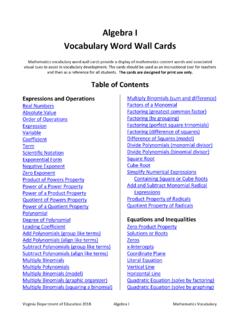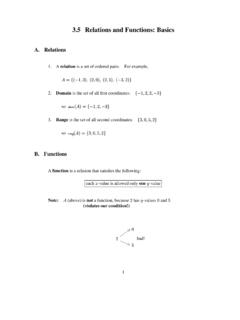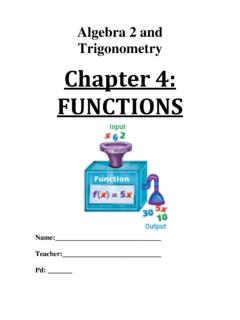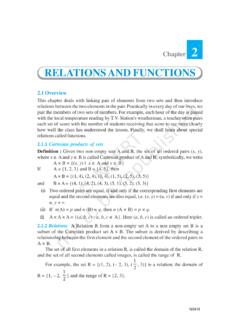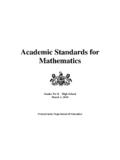Transcription of RELATIONS AND FUNCTIONS - NCERT
1 Relation R from a non-empty set A to a non empty set B is a subset of the Cartesianproduct A B. The set of all first elements of the ordered pairs in a relation R from aset A to a set B is called the domain of the relation R. The set of all second elements ina relation R from a set A to a set B is called the range of the relation R. The whole setB is called the codomain of the relation R. Note that range is always a subset of RelationsA relation R in a set A is subset of A A. Thus empty set and A A are two extremerelations.(i) A relation R in a set A is called empty relation, if no element of A is related to anyelement of A, , R = A A.(ii) A relation R in a set A is called universal relation, if each element of A is relatedto every element of A, , R = A A.
2 (iii) A relation R in A is said to be reflexive ifaRafor alla A, R is symmetric ifaRb bRa, a,b A and it is said to be transitive ifaRb andbRc aRc a, b, c A. Any relation which is reflexive, symmetric and transitive is calledan equivalence relation. Note: An important property of an equivalence relation is that it divides the setinto pairwise disjoint subsets called equivalent classes whose collection is calleda partition of the set. Note that the union of all equivalence classes givesthe whole of FUNCTIONS (i) A functionf : X Y is defined to be one-one (or injective), if the images ofdistinct elements of X underf are distinct, ,x1,x2 X,f (x1) =f(x2) x1 =x2.(ii) A functionf : X Y is said to be onto (or surjective), if every element of Y is theimage of some element of X underf, , for everyy Y there exists an elementx X such thatf (x) = AND FUNCTIONS2 MATHEMATICS(iii) A functionf : X Y is said to be one-one and onto (or bijective), iff is both one-one and of FUNCTIONS (i) Letf : A B andg : B C be two FUNCTIONS .
3 Then, the composition off andg, denoted byg o f, is defined as the functiong o f : A C given byg o f (x) =g (f(x)), x A.(ii) Iff : A B andg : B C are one-one, theng o f : A C is also one-one(iii) Iff : A B andg : B C are onto, theng o f : A C is also , converse of above stated results (ii) and (iii) need not be true. Moreover,we have the following results in this direction.(iv) Letf : A B andg : B C be the given FUNCTIONS such thatg o f is is one-one.(v) Letf : A B andg : B C be the given FUNCTIONS such thatg o f is onto. Theng is Function(i) A functionf : X Y is defined to be invertible, if there exists a functiong : Y X such thatg o f = Ix andf o g = IY. The functiong is called the inverseoff and is denoted byf 1.
4 (ii) A functionf : X Y is invertible if and only iff is a bijective function.(iii) Iff : X Y,g : Y Z andh : Z S are FUNCTIONS , thenh o(g o f) = (h o g)o f.(iv) Letf : X Y andg : Y Z be two invertible FUNCTIONS . Theng o f is alsoinvertible with (g o f) 1 = f 1o g Operations(i) A binary operation* on a set A is a function* : A A A. We denote* (a,b)bya*b.(ii) A binary operation* on the set X is called commutative, ifa*b =b*a for everya,b X.(iii) A binary operation* : A A A is said to be associative if(a*b)*c =a* (b*c), for everya, b,c A.(iv) Given a binary operation* : A A A, an elemente A, if it exists, is calledidentity for the operation*, ifa*e =a =e*a, a AND FUNCTIONS 3(v) Given a binary operation* : A A A, with the identity elemente in A, anelementa A, is said to be invertible with respect to the operation*, if thereexists an elementb in A such thata*b =e =b*a andb is called the inverse ofa and is denoted bya Solved ExamplesShort Answer ( )Example 1 Let A = {0, 1, 2, 3} and define a relation R on A as follows:R = {(0, 0), (0, 1), (0, 3), (1, 0), (1, 1), (2, 2), (3, 0), (3, 3)}.
5 Is R reflexive? symmetric? transitive?SolutionR is reflexive and symmetric, but not transitive since for (1, 0) R and(0, 3) R whereas (1, 3) 2 For the set A = {1, 2, 3}, define a relation R in the set A as follows:R = {(1, 1), (2, 2), (3, 3), (1, 3)}.Write the ordered pairs to be added to R to make it the smallest equivalence (3, 1) is the single ordered pair which needs to be added to R to make it thesmallest equivalence 3 Let R be the equivalence relation in the setZ of integers given byR = {(a,b) : 2 dividesa b}. Write the equivalence class [0].Solution[0] = {0, 2, 4, 6,..}Example 4 Let the functionf :R R be defined byf (x) = 4x 1, x R. Then,show thatf is any two elementsx1,x2 R such thatf(x1) =f (x2), we have4x1 1 = 4x2 1 4x1 = 4x2, , x1 =x2 Hencef is 5 Iff = {(5, 2), (6, 3)},g = {(2, 5), (3, 6)}, writef o o g ={(2, 2), (3, 3)}Example 6 Letf :R R be the function defined byf (x) = 4x 3 x R.
6 Thenwritef MATHEMATICSS olution Given that f(x) = 4x 3 = y (say), then4x =y + 3 x =34y+Hencef 1(y) =34y+ f 1(x) =34x+Example 7 Is the binary operation* defined onZ (set of integer) bym*n =m n +mn m,n Z commutative?SolutionNo. Since for 1, 2 Z, 1* 2 = 1 2 + = 1 while 2* 1 = 2 1 + = 3so that 1* 2 2* 8 Iff = {(5, 2), (6, 3)} andg = {(2, 5), (3, 6)}, write the range off The range off= {2, 3} and the range ofg = {5, 6}.Example 9If A = {1, 2, 3} andf,g are RELATIONS corresponding to the subset of A Aindicated against them, which off,g is a function? Why?f= {(1, 3), (2, 3), (3, 2)}g= {(1, 2), (1, 3), (3, 1)}Solution f is a function since each element of A in the first place in the ordered pairsis related to only one element of A in the second place whileg is not a function because1 is related to more than one element of A, namely, 2 and 10If A = {a,b,c,d} andf = {a, b), (b,d), (c,a), (d,c)}, show thatf is one-one from A onto A.
7 Findf is one-one since each element of A is assigned to distinct element of the setA. Also,f is onto sincef (A) = A. Moreover,f 1 = {(b,a), (d,b), (a,c), (c,d)}.Example 11In the setN of natural numbers, define the binary operation* bym*n = (m,n),m,n N. Is the operation* commutative and associative?Solution The operation is clearly commutative since m*n = (m,n) = (n,m) =n*m m,n is also associative because forl,m,n N, we have l* (m*n) =g. c. d (l, (m,n))= (g. c. d (l,m),n) = (l*m)* AND FUNCTIONS 5 Long Answer ( )Example 12In the set of natural numbersN, define a relation R as follows: n,m N,nRm if on division by 5 each of the integersn andm leaves the remainderless than 5, one of the numbers 0, 1, 2, 3 and 4.
8 Show that R is equivalence , obtain the pairwise disjoint subsets determined by is reflexive since for eacha N,aRa. R is symmetric since ifaRb, thenbRafora,b N. Also, R is transitive since fora,b,c N, ifaRb andbRc, R is an equivalence relation inN which will partition the setN into the pairwisedisjoint subsets. The equivalent classes are as mentioned below:A0 = {5, 10, 15, 20 ..}A1 = {1, 6, 11, 16, 21 ..}A2 = {2, 7, 12, 17, 22, ..}A3 = {3, 8, 13, 18, 23, ..}A4 = {4, 9, 14, 19, 24, ..}It is evident that the above five sets are pairwise disjoint andA0 A1 A2 A3 A4 =40 Aii= = 13 Show that the functionf :R R defined byf (x) =2,1xxx +R, isneither one-one nor ,x2 R, considerf (x1) =f (x2) 12221211xxxx=++ x122x+x1=x221x+x2 x1x2(x2 x1) =x2 x1 x1= x2 or x1x2 = 1We note that there are point,x1 andx2 withx1 x2 andf (x1) =f (x2), for instance, ifwe takex1 = 2 andx2=12, then we havef (x1) =25 andf (x2) =25 but122.
9 Hencef is not one-one. Also,f is not onto for if so then for 1 R x R such thatf (x) = 16 MATHEMATICS which gives211xx=+. But there is no suchx in the domainR, since the equationx2 x + 1 = 0 does not give any real value 14 Letf,g :R R be two FUNCTIONS defined asf (x) =x +x andg (x) =x x x R. Then, findf o g andg o (x) =x +x which can be redefined asf (x) =2 if00 if0xxx < Similarly, the functiong defined byg (x) =x xmay be redefined asg (x) =0 if0 2 if0xxx < Therefore,g o fgets defined as :Forx 0, (g o f) (x) =g (f (x) =g (2x) = 0and forx< 0, (g o f) (x) =g (f (x) =g (0) = , we have (g o f) (x) = 0, x ,f o g gets defined as:Forx 0, (f o g) (x) =f (g (x) =f (0) = 0,and forx< 0, (f o g) (x) =f (g(x)) =f ( 2x) = ,0() ( )4 ,0xf o gxx x> = < Example 15 LetR be the set of real numbers andf :R R be the function definedbyf (x) = 4x + 5.)))
10 Show thatf is invertible and findf the functionf :R R is defined asf (x) = 4x + 5 =y (say). Then 4x =y 5 or x =54y . RELATIONS AND FUNCTIONS 7 This leads to a functiong :R R defined asg (y) =54y .Therefore,(g o f) (x) =g(f(x) =g (4x + 5)=45 54x+ =xorg o f= IRSimilarly (f o g) (y) =f(g(y))=54yf =5454y + = yorf o g= IR .Hencef is invertible and f 1 =g which is given byf 1 (x) =54x Example 16 Let* be a binary operation defined onQ. Find which of the followingbinary operations are associative(i)a*b =a b fora,b Q.(ii)a*b =4abfor a,b Q.(iii)a*b =a b +ab fora,b Q.(iv)a*b =ab2 fora,b (i)* is not associative for if we takea = 1,b = 2 andc = 3, then(a*b)*c = (1* 2)* 3 = (1 2)* 3 = 1 3 = 4 anda* (b*c) = 1* (2* 3) = 1* (2 3) = 1 ( 1) = MATHEMATICSThus (a*b)*c a* (b*c) and hence* is not associative.)










